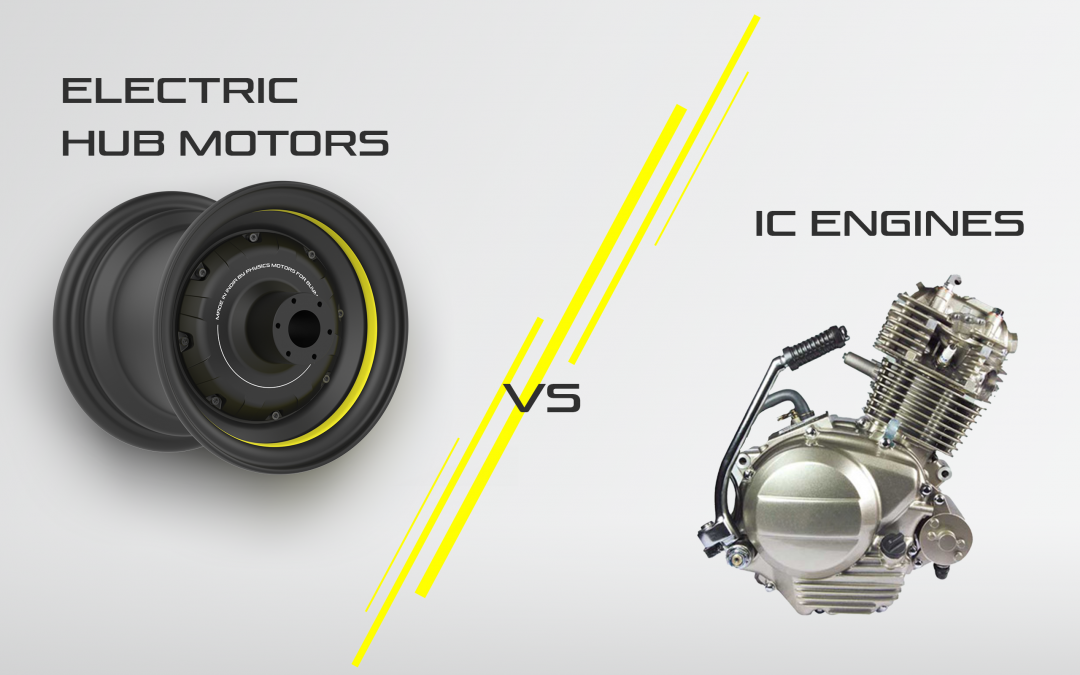Imagine a world where the traditional constraints of engines and transmissions fade away, replaced by a compact, efficient, and integrated solution! In today’s world, this is exactly where we are moving towards with electric scooter motors. Before we delve into the details, let us present you with a cool fact!
Did you know that Internal Combustion (IC) petrol engines typically consist of around 2,000 moving parts, while their electric vehicle (EV) counterparts have only 20-25? That’s an astonishing 100:1 ratio! This means that for every 100 moving parts in a petrol engine, there’s only 1 moving part in an EV two-wheeler. This reduction in complexity is one of the remarkable advantages of EVs
So, how is this significant reduction in moving components possible? The answer lies in the functioning of electric scooter motors, which can almost feel like pure magic, especially in the case of HUB motors. Let’s delve into the fascinating features they bring to the table and explore what makes them so special!
What is a HUB motor in Electric Two wheelers?
In simple terms, a hub motor serves as a replacement for IC engines. It operates solely on the principles of electromagnetic induction, eliminating the need for components like spark plugs, pistons, camshafts, and other moving parts typically found in IC engines.
Hub motors consist of two main parts: the stator and the rotor. In the case of hub motors used in electric two-wheelers, the stator is composed of permanent magnets attached to the wheel hub, while the stationary stator is mounted on bearings. When power is supplied, the electromagnetic induction principle comes into play, enabling the transfer of drive to the wheels.
What are other positions for Electric scooter motors compared to IC Engines?
EV two-wheeler motors can be positioned in various ways, depending on the design and requirements of the vehicle. Due to their compact size and space-saving nature, they offer great flexibility in terms of placement. In addition to the previously mentioned hub position, another commonly used position is known as the mid-drive.
In a mid-drive setup, the motor is positioned in the center of the vehicle, and a chain or belt connects it to the rear wheel to provide propulsion. Unlike hub motors, this location allows for a more balanced weight distribution and improves handling. The motor drives the rear wheel using a chain or belt drive system, leveraging the existing gears of the vehicle for efficient power transfer.
Electric Scooter Motor Vs IC engines! The differences that gives EV motors an edge
When compared to IC engines, EV motors are still at an infancy stage when it comes to driving automobiles. However they still have a competitive edge over IC engines that makes them a more sustainable option for the future
Compact Design:
One of the primary advantages of EV motors, specifically hub motors, over IC engines is their ability to enable a compact and integrated design. By directly incorporating the motor into the wheel hub, they save a significant amount of space, thereby allowing for additional storage options. In the case of Indibike, this design choice has resulted in ample leg space for riders, thereby maximizing their comfort and convenience.
Simplified Drivetrain:
One crucial factor in favor of Hub motors is their direct power transmission to the wheel, which eliminates the requirement for intricate drivetrain components like chains or belts. This simplification not only reduces the number of moving parts but also enhances efficiency, lowers maintenance needs, and provides a smoother riding experience.
Regenerative Braking:
When comparing IC engines and EV motors, it is worth noting that electric scooter motors often come with built-in regenerative braking capabilities. This feature allows the motor to function as a generator when the rider applies the brakes, converting kinetic energy into electrical energy and storing it in the battery. By utilizing regenerative braking, hub motors enhance energy efficiency and effectively extend the overall range of electric two-wheelers.
All-Weather Performance:
In comparison to IC engines, hub motors have an advantage as they do not require air intake. This feature, coupled with the enclosed design of the hub motor, provides superior protection against dust, dirt, and water when compared to other motor configurations.
Conclusion:
It is evident that electric motors exhibit numerous advantages over IC engines. From a sustainable and economical standpoint, electric motors should undoubtedly be the preferred choice moving forward.
At Indibike, we pay meticulous attention to every component, ensuring careful consideration and thoughtful planning. Each component is purposefully designed to enhance practicality, safety, and overall aesthetics of our vehicles.
If you are interested in exploring what we have built, we invite you to book a test ride and experience Indibike firsthand

